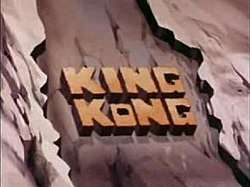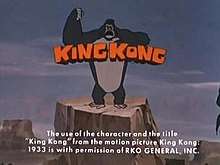The King Kong Show
The King Kong Show (Japanese: キングコング・001/7親指トム) is an American/Japanese anime-influenced series produced by Videocraft International and Toei Animation. ABC ran the series in the United States between September 10, 1966, and August 31, 1969.[1] It is the first anime series produced in Japan for an American company (not counting Rankin/Bass' previous Animagic stop motion productions, also animated in Japan).[2]
| King Kong | |
|---|---|
 Title card | |
| Voices of | Carl Banas Susan Conway John Drainie Billie Mae Richards Alf Scopp Paul Soles Bernard Cowan |
| Theme music composer | Maury Laws |
| Country of origin | United States Canada Japan |
| Original language(s) | English Japanese |
| No. of seasons | 3 |
| No. of episodes | 26 |
| Production | |
| Executive producer(s) | Arthur Rankin Jr. Jules Bass |
| Producer(s) | William J. Keenan Larry Roemer |
| Running time | 30 minutes |
| Production company(s) | Videocraft International Toei Animation |
| Release | |
| Original network | ABC |
| Picture format | Color |
| Audio format | Mono |
| Original release | September 10, 1966 – August 31, 1969 |
This series is an animated adaptation of the famous movie monster King Kong with character designs by Jack Davis and Rod Willis. In this series, the giant ape befriends the Bond family, with whom he goes on various adventures, fighting monsters, robots, aliens, mad scientists and other threats.[3] Unlike King Kong's destructive roles in his movies, the cartoon turned him into a protector of humanity.[4]
Included is a spoof of the spy films of the 1960s called Tom of T.H.U.M.B., about a secret agent for "T.H.U.M.B." ("The Tiny Human Underground Military Bureau) named Tom and his Asian "sidekick" Swinging Jack, who are accidentally shrunk by a ray to three inches tall.[5] The pair are sent out in a variety of miniature vehicles by their bad-tempered boss, Chief Homer J. Chief, to foil the fiendish plots of "M.A.D." (Maladjusted, Anti-social and Darn mean), an evil organization made up of black-hatted and black-cloaked scientists "bent on destroying the world for their own gains".
In Japan, the first two episodes were combined into a 56-minute special, titled King of the World: The King Kong Show (世界の王者 キングコング大会, Sekai no Ôja: Kingu Kongu Taikai), and was broadcast on NET (now TV Asahi) on December 31, 1966. The rest of the series, with the inclusion of Tom of T.H.U.M.B., was broadcast on NET as King Kong & 001/7 Tom Thumb (Kingu Kongu * 001/7 Oyayubi Tomu - キングコング・001/7親指トム), and aired on April 5 to October 4, 1967, with a total of 26 episodes.
This series was successful enough for Rankin/Bass to extend the Kong franchise to another Japanese company, Toho (which already produced the hit King Kong vs. Godzilla in 1962). This resulted in Ebirah, Horror of the Deep (originally intended as a Kong film) and King Kong Escapes, which was based on The King Kong Show.
On November 15, 2005, Sony Wonder released the first eight episodes (two King Kong cartoons separated by a Tom of T.H.U.M.B. cartoon) on two DVD releases titled King Kong: The Animated Series Volume 1 and King Kong: The Animated Series Volume 2. The pilot episode was included, in its two parts for American syndication, between the two DVDs.
Music
Theme music for the series was recorded in London, England, in 1965, using primarily British studio musicians. Canadian conductor, vocalist and former Kitchener-Waterloo Record entertainment columnist Harry Currie provided vocal talent on the recording.
Characters

- King Kong - The title character. The Eighth Wonder of the World, Kong was discovered on Mondo Island (sometimes known as Skull Island) by Bobby Bond, whom he saved from being eaten by a Tyrannosaurus rex. He has also saved Bobby and his family from other disasters afterwards. Ever since, he has become the family's mascot and a hero.
- Professor Bond - The head/father of the Bond family.
- Susan Bond - The teenage daughter. She is always somewhat perplexed by Bobby and Kong's friendship. She is the basis for Susan Watson (Linda Miller) in King Kong Escapes. Susan is always the one that knows what Dr. Who is up to and her fear is dreaming about snakes.
- Bobby Bond - The young son and Kong's closest companion. Saved by Kong from being eaten by a Tyrannosaurus rex, and they have been friends ever since.
- Captain Englehorn - A friend to the family and Professor Bond's ship captain. Based on the character from the original King Kong film.
- Dr. Who - The popular recurring villain. A bald, big-headed and bespectacled mad scientist who wants to capture Kong and use him for his own evil schemes. He has no relation to the character from the British sci-fi TV series. He is the basis for Hideyo Amamoto's character Dr. Who in King Kong Escapes.
- Mechani-Kong - Kong's robot double, invented by Dr. Who. Neither the Bonds nor Captain Englehorn know (or ever figure out) that Dr. Who invented it, however. It appears in two King Kong segments, "MechaniKong" (the second King Kong segment from Episode 10) and "Anchors Away" (the second King Kong segment from Episode 25). Two different versions of it appear in each of the two segments; both of them are destroyed by Kong. It is also Kong's nemesis in King Kong Escapes.
Episode guide

- 1. King Kong (1-hour long pilot episode). In American syndication, the episode was split into two parts, which were titled "A Friend in Need" and "The Key to the City".
The following episode list describes the show as it originally aired, beginning with a six-minute King Kong segment, followed by a six-minute Tom of T.H.U.M.B. segment, then followed by another six-minute King Kong segment.
- 2. Under the Volcano/For the Last Time, Feller...I'm Not Bait!/The Treasure Trap
- 3. The Horror of Mondo Island/Hey, That Was A Close One World!/Dr. Who
- 4. Rocket Island/I Was A 91⁄2 oz. Weakling 'Till One Day.../The African Bees
- 5. The Hunter/I Was A Starling for the USA!/The Space Men
- 6. The Jinx of the Sphinx/Cool Nerves and...Steady Hands/The Greeneyed Monster
- 7. The Top of the World/All Guys from Outer Space are Creeps/The Golden Temple
- 8. The Electric Circle/Mechanical Granma/Mirror of Destruction
- 9. Tiger Tiger/The Day We Almost Had It/The Vise of Dr. Who
- 10. King Kong's House/Tom Makes History/MechaniKong
- 11. The Giant Sloths/Tom Scores Again/The Legend of Loch Ness
- 12. Dr. Bone/Blow, Jack, Blow!/No Man's Snowman
- 13. The Desert Pirates/Tom and the TV Pirates/Command Performance
- 14. The Sea Surrounds Us/The Girl from M.A.D./Show Biz
- 15. The Wizard of Overlord/Just One Of Those Nights/Perilous Porpoise
- 16. The Trojan Horse/Runt of 1,000 Faces/The Man from K.O.N.G.
- 17. Caribbean Cruise/Hello, Dollies!/Diver's Dilemma
- 18. The Great Sun Spots/Pardner/Kong is Missing
- 19. In the Land of the Giant Trees/Beans is Beans/Captain Kong
- 20. Statue of Liberty Play/What Goes Up.../Pandora's Box
- 21. The Thousand Year Knockout/Our Man, The Monster/Desert City
- 22. Eagle Squadron/Never Trust A Clam/The Kong of Stone
- 23. Murderer's Maze/Drop that Ocean, Feller/The Great Gold Strike
- 24. It Wasn't There Again Today/Plug that Leak/The Mad Whale
- 25. The King Kong Diamond/The Scooby/Anchors Away
Reception
In the 2007 book Comics Gone Ape! The Missing Link to Primates in Comics, comics historian Michael Eury writes, "The Rankin/Bass King Kong was an early case of identity theft, where the Kong name was appropriated (fully under license) to describe a new character that, at best, only remotely resembled his namesake. This was Kong done wrong."[6]
Cast
- Billie Mae Richards - Bobby Bond
- Carl Banas - Professor Bond
- Susan Conway - Susan Bond
- John Drainie
- Alfie Scopp
- Paul Soles
Crew
- Producer - William J. Keenan
- Executive Producers - Arthur Rankin Jr., Jules Bass
- Associate Producer - Larry Roemer
- Music/Lyrics - Maury Laws, Jules Bass
- Recording Supervisor - Bernard Cowan
- Sound/Effects - Bill Giles, Stephen Frohock, Bill Dowding, Frederick Tudor
- Animation Production - Toei Studios
- Character Designs - Jack Davis, Rod Willis
- Animation Continuity - Don Duga
- Story Editor - Cherney Berg
References
- Clements, Jonathan; McCarthy, Helen (2006). The Anime Encyclopedia (2nd expanded ed.). Berkeley, California: Stone Bridge Press. p. 313340. ISBN 1-84576-500-1.
- Erickson, Hal (2005). Television Cartoon Shows: An Illustrated Encyclopedia, 1949 Through 2003 (2nd ed.). McFarland & Co. pp. 477–478. ISBN 978-1476665993.
- Woolery, George W. (1983). Children's Television: The First Thirty-Five Years, 1946-1981. Scarecrow Press. pp. 164–165. ISBN 0-8108-1557-5. Retrieved 14 March 2020.
- Perlmutter, David (2018). The Encyclopedia of American Animated Television Shows. Rowman & Littlefield. pp. 342–343. ISBN 978-1538103739.
- Hyatt, Wesley (1997). The Encyclopedia of Daytime Television. Watson-Guptill Publications. p. 250. ISBN 978-0823083152. Retrieved 19 March 2020.
- Eury, Michael (2007). Comics Gone Ape! The Missing Link to Primates in Comics. TwoMorrows Publishing. p. 33. ISBN 978-1893905627.
External links
- The King Kong Show overview (in-depth Japanese site about the series)
- Sekai no Ôja · King Kong Daikai in Animemorial (the Japanese name of the TV special)
- King Kong · 001 / 7 Oyayubi Tom in Animemorial (contains Japanese episodes list, cast & staff)
- "The King Kong Show"—an in-depth article about the series, featuring rare shots of various merchandise and tie-ins related to the series (French site)
- "SciFi Japan King Kong Cartoon Series Guide"—an in-depth article about the series
- King Kong on IMDb
- The King Kong Show at the Big Cartoon DataBase
- King Kong at TV.com
- King Kong - 00 1/7 Tom Thumb (anime) at Anime News Network's encyclopedia
- allcinema キングコング